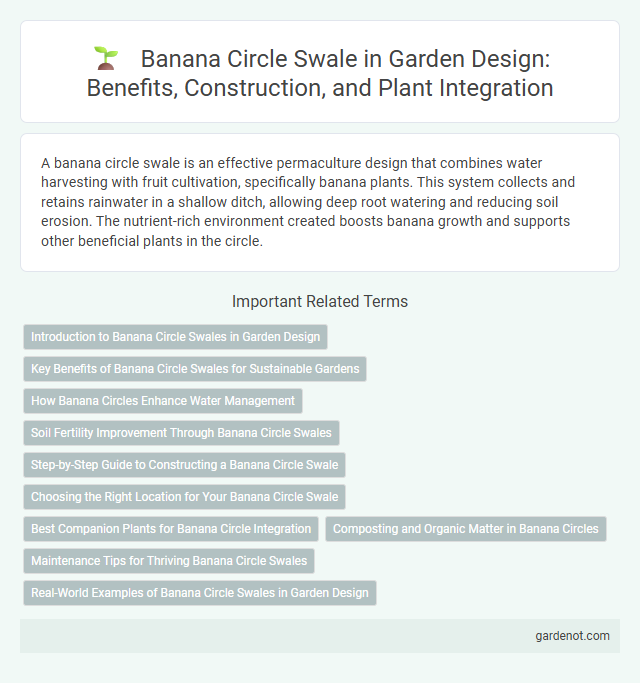A banana circle swale is an effective permaculture design that combines water harvesting with fruit cultivation, specifically banana plants. This system collects and retains rainwater in a shallow ditch, allowing deep root watering and reducing soil erosion. The nutrient-rich environment created boosts banana growth and supports other beneficial plants in the circle.
Introduction to Banana Circle Swales in Garden Design
Banana circle swales are a permaculture design feature that combines water harvesting with organic food production, using concentric berms and swales shaped to resemble a banana leaf. These swales capture and infiltrate rainwater efficiently, reducing soil erosion while creating a microclimate ideal for growing bananas, other fruit trees, and companion plants. Integrating banana circle swales in garden design enhances water management and boosts biodiversity by supporting diverse plant species in a self-sustaining ecosystem.
Key Benefits of Banana Circle Swales for Sustainable Gardens
Banana circle swales enhance water retention and improve soil fertility by capturing runoff and creating a microclimate suited for banana plants and companion species. These swales support biodiversity and reduce erosion, promoting sustainable garden ecosystems with minimal maintenance. Efficient nutrient recycling through organic matter buildup further boosts plant growth and soil health in permaculture designs.
How Banana Circles Enhance Water Management
Banana circles integrate swale design by capturing and directing runoff water, promoting efficient infiltration and reducing soil erosion. They create a microcatchment that supports deep root growth and moisture retention, enhancing drought resilience in surrounding plants. This sustainable water management technique improves soil health while maximizing the use of rainwater in permaculture systems.
Soil Fertility Improvement Through Banana Circle Swales
Banana circle swales enhance soil fertility by combining water retention with organic matter decomposition, creating a nutrient-rich environment for plant growth. The swale's design traps runoff water, reducing erosion while maintaining consistent moisture levels that promote microbial activity and nutrient cycling. This sustainable system supports robust banana plants whose biomass contributes continuous organic inputs, further enriching the soil structure and fertility.
Step-by-Step Guide to Constructing a Banana Circle Swale
Construct a Banana Circle Swale by first selecting a gently sloping site and marking the contour lines to ensure proper water capture and distribution. Excavate a sunken garden area in the center, surrounded by a berm created from the excavated soil, shaping it into a banana-like crescent that maximizes water retention and soil fertility. Integrate organic mulch and plant diverse species such as banana plants, comfrey, and nitrogen-fixing trees to enhance nutrient cycling and maintain moisture within the swale ecosystem.
Choosing the Right Location for Your Banana Circle Swale
Selecting the ideal location for your banana circle swale involves analyzing sun exposure, water runoff patterns, and soil type to maximize banana growth and water retention. Position the swale on a gentle slope to capture and slow runoff, ensuring moisture is evenly distributed for the banana plants. Avoid low-lying areas prone to waterlogging and prioritize well-drained soil with rich organic matter to promote healthy root development.
Best Companion Plants for Banana Circle Integration
Banana circles thrive when integrated with companion plants like comfrey, which enhances soil fertility through nitrogen fixation, and sweet potatoes, which act as ground cover to suppress weeds and retain moisture. Leguminous plants such as pigeon peas improve soil structure and provide organic matter, promoting healthier banana growth within the swale system. Incorporating diverse flowering plants attracts pollinators and beneficial insects, boosting overall ecosystem resilience and productivity in the banana circle swale.
Composting and Organic Matter in Banana Circles
Banana circle swales enhance soil fertility through efficient composting and organic matter integration, creating a nutrient-rich environment for plant growth. The design facilitates the breakdown of organic waste, transforming kitchen scraps and garden debris into valuable humus that improves soil structure and moisture retention. This cycle supports a sustainable ecosystem by promoting microbial activity and reducing the need for synthetic fertilizers in permaculture practices.
Maintenance Tips for Thriving Banana Circle Swales
Regularly monitor soil moisture levels in banana circle swales to ensure optimal hydration without waterlogging, promoting healthy root development. Mulch the swale with organic materials like straw or leaves to retain moisture, suppress weeds, and enhance soil fertility through natural decomposition. Periodic pruning of banana leaves and removal of dead plant material prevent disease and improve air circulation, supporting vigorous growth.
Real-World Examples of Banana Circle Swales in Garden Design
Banana circle swales optimize water retention and soil fertility by combining swale earthworks with organic waste composting in a circular design, mimicking natural ecosystems. Real-world examples of banana circle swales in garden design can be found in permaculture projects worldwide, such as in tropical regions of Southeast Asia and Central America, where gardeners integrate banana plants, comfrey, and other nutrient accumulators to create self-sustaining garden beds. These installations improve microclimate, reduce erosion, and increase food production while enhancing biodiversity in home gardens and community farms.
Banana circle swale Infographic

 gardenot.com
gardenot.com